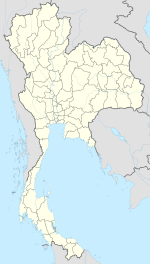Songkurai
Song Karia
ซองกาเรีย Songkurai | |
|---|---|
Village | |
 Bridge building at Camp Songkurai (1943) | |
| Coordinates:15°13′00″N98°26′43″E/ 15.2167°N 98.4453°E | |
| Country | Thailand |
| Province | Kanchanaburi |
| District | Sangkhla Buri |
| Tambon | Nong Lu |
| Time zone | UTC+7(ICT) |
Ban Song Karia[1](Thai:บ้านซองกาเรีย), also spelledSongkalia(ซองกาเลีย) and alternatively known asSongkurai(fromJapanese:ソンクライ), is a village in theSangkhla Buri Districtof theKanchanaburi Province,Thailand near the border withMyanmarat theThree Pagodas Pass.It was the location of three World War IIJapanese Prisoner of War Campslocated about 13 kilometres (8.1 mi) south of the Thai/Burma border.[2]
Camp Songkurai
[edit]Songkurai was the location of three work camps. The first 393 Australian prisoners arrived on 25 May 1943.[3]In August 1943,[4]the British 'F' Force consisting of 670 British and 1,020 Australian prisoners was concentrated at Songkurai.[3]The prisoners were tasked to create a 15 kilometre stretch of railroad including a wooden bridge over theSongkalia River(Huai Ro Khi).[5][6]
The prisoners wereforcedto work, under harsh conditions, on the construction of theBurma Railway.They suffered extreme hardship from poor rations, disease and brutal treatment. The bridge over the Songkalia River became known as the Bridge of 600, because 600 prisoners died during its construction.[5]When the first POWs arrived, there was already acholeraoutbreak at the Asian forced labourers camp. The outbreak was finally beaten in mid-June. On 10 August, cholera returned.[3]
On 17 November 1943, the last prisoners left the camps[4]which have now been taken over by the jungle.[2]
Later history
[edit]AfterJapan's capitulation,the British Army removed about four kilometres of rail road track between Nikki (Ni Thea) and Songkurai because it was deemed unsafe.[7]First lieutenantHiroshi Abe,the construction supervisor, was later convicted as a B/C class war criminal and sentenced to death. His sentence was later commuted to life imprisonment. He served 11 years.[8]
A school has been built on a former camp site, and the river is now crossed by Highway 323 towards the border.[6]The village is currently known as Ban Song Karia.[1]
References
[edit]- ^ab"More illegal job seekers caught on western border".Bangkok Post.Retrieved31 January2022.
- ^abKen Gray."Mates".POWs of Japan.Retrieved29 January2022.
- ^abc"Kami Sonkurai (Upper Sonkurai) No. 2 Camp 299.20 km Camp - Thailand".2/4th Machine Gun Battalion.Retrieved29 January2022.
- ^ab"Sunkurai".Japanese Krijgsgevangenkampen(in Dutch).Retrieved29 January2022.
- ^ab"Songkurai".Far East POW Family.Retrieved29 January2022.
- ^ab"Songkurai camp".Anzac Portal.Retrieved31 January2022.
- ^"Historical Fact on the Burma Death Railroad Thailand Hellfire pass Prisoners conditions".Archived fromthe originalon 18 January 2012.
- ^Tony Lloyd(4 December 1996)."Bound Volume Hansard - Debate".House of Parliament - Commons Debate.Retrieved29 January2022.

